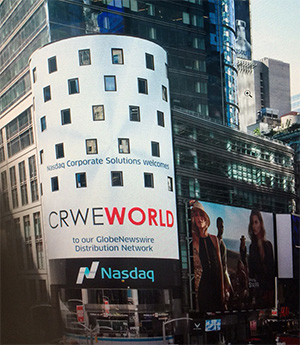Johnson & Johnson announces first head-to-head study comparing IMAAVY™ with an alternative FcRn blocker in generalized myasthenia gravis (gMG) at AANEM Annual Meeting
Johnson & Johnson announces first head-to-head study comparing IMAAVY™ with an alternative FcRn blocker in generalized myasthenia gravis (gMG) at AANEM Annual Meeting |
| [29-October-2025] |
The EPIC study will evaluate treatment with IMAAVY™ versus efgartigimod in adults with gMG and will include a treatment-switch arm The Company also announced new data from the pivotal Vibrance-MG study in which pediatric patients receiving treatment with IMAAVY™ demonstrated 72 weeks of sustained reduction in immunoglobulin G (IgG), sustained disease control and no new safety concerns IMAAVY™ is the only FcRn blocker for anti-AChR and anti-MuSK antibody positive adult and pediatric gMG patients aged 12 and older that has demonstrated sustained disease control SPRING HOUSE, Pa., Oct. 29, 2025 /PRNewswire/ -- Johnson & Johnson (NYSE: JNJ) today announced plans to initiate the first head-to-head study comparing FcRn blockers for patients with generalized myasthenia gravis (gMG), which aims to affirm IMAAVY™ (nipocalimab-aahu) as the FcRn blocker of choice for appropriate gMG patients. The EPIC study design and Vibrance-MG Phase 2/3 long-term extension (LTE) data are among 38 abstracts the Company will present at the 2025 Myasthenia Gravis Foundation of America (MGFA) Scientific Session and the American Association of Neuromuscular and Electrodiagnostic Medicine (AANEM) Annual Meeting. EPIC Phase 3b Adult Study "The EPIC study marks an important step forward in advancing care for people living with gMG," said Leonard L. Dragone, M.D., Ph.D., Disease Area Leader, Autoantibody and Rheumatology, Johnson & Johnson Innovative Medicine. "By directly comparing IMAAVY to another FcRn blocker and incorporating a treatment-switch arm, EPIC will provide critical insights into how physicians can best start and transition gMG patients within this class. These findings will help guide real-world clinical decisions and strengthen confidence in the most effective treatment strategies." Vibrance Pediatric Phase 2/3 Study The Vibrance-MG LTE analysis builds on positive and sustained outcomes in pediatric patients with gMG whose symptoms are not well controlled with standard treatments.2 New data show that treatment with IMAAVY™ led to a rapid and sustained reduction in IgG levels – with a median reduction of ~73% by Week 24.2 Improvements in both daily functionc and muscle strengthd were also observed through 72 weeks, indicating sustained disease control over time.2 The treatment was generally well tolerated and no new safety concerns have emerged thus far during extended follow-up.2 These findings are consistent with the positive results from the pivotal Vivacity-MG3 study and ongoing open-label extension (OLE) in adult patients with gMG. Together, the data highlight the differentiated treatment profile of IMAAVY™ across key antibody subtypes (anti-acetylcholine receptor positive [AChR+], anti-muscle-specific tyrosine kinase positive [MuSK+]) and the potential to provide long-term sustained disease control for the broadest population of people living with gMG.2,3 "Pediatric patients with gMG have long been an underserved population in neuromuscular disease research," said Jonathan Strobere, M.D., Director of the Pediatric Neuromuscular Program and Professor of Pediatrics and Neurology at the University of California at San Francisco. "These new Vibrance-MG LTE pediatric data are especially encouraging, showing treatment with IMAAVY achieved sustained meaningful improvements in daily function and muscle strength, echoing the results seen in the Vivacity-MG3 OLE study in adults. These data represent an important potential advance in the care of pediatric patients, offering hope for lasting disease control." IMAAVY™ is approved by the U.S. Food and Drug Administration for adult and pediatric patients (12 years of age and older) with anti-AChR or anti-MuSK antibody positive gMG, in Brazil by ANVISA for anti-AChR, anti-MuSK or anti-LRP4 antibody positive adults and pediatric patients aged 12 and older and in Japan by the Pharmaceuticals and Medical Devices Agency for the treatment of all patients living with gMG. Health authority submissions seeking approval for nipocalimab in the treatment of gMG are currently under review with several regulatory authorities worldwide.
ABOUT GENERALIZED MYASTHENIA GRAVIS ( gMG) Myasthenia gravis (MG) is an autoantibody disease in which the immune system mistakenly makes antibodies (e.g., anti-acetylcholine receptor [AChR], anti-muscle-specific tyrosine kinase [MuSK]), which target proteins at the neuromuscular junction and can block or disrupt normal signaling from nerves to muscles, thus impairing or preventing muscle contraction.5,6,7 The disease impacts an estimated 700,000 people worldwide.5 The disease affects both men and women and occurs across all ages, racial and ethnic groups, but most frequently starts in young women and older men.8 Roughly 50 percent of individuals diagnosed with MG are women, and about one in five of those women are of child-bearing potential.9,10,11 Approximately 10 to 15% of new cases of MG are diagnosed in pediatric patients 12-17 years of age.12,13,14 Among juvenile MG patients, girls are affected more often than boys with over 65% of pediatric MG cases in the U.S. diagnosed in girls.15,16,17 Initial disease manifestations are usually eye-related but approximately 85% of MG patients experience additional advancements to the disease manifestations, referred to as generalized myasthenia gravis (gMG). This is characterized by severe muscle weakness and difficulties in speech and swallowing.18,19,20,21,22 Approximately 100,000 individuals in the U.S. are living with gMG.23 Vulnerable gMG populations, such as pediatric patients, have more limited therapeutic options.24 ABOUT THE PHASE 2/3 VIBRANCE-MG STUDY The Phase 2/3 Vibrance-MG study (NCT05265273) is an on-going open-label study to determine the effect of nipocalimab in pediatric participants with gMG.25 Seven participants aged 12-17 years with a diagnosis of gMG as reflected by a Myasthenia Gravis Foundation of America (MGFA) Class of II through IV at screening, and an insufficient clinical response to ongoing, stable SOC therapy, have been enrolled in the trial.26 Participants must have a positive blood test for either anti-AChR or anti-MUSK autoantibodies. The study consists of a screening period of up to four weeks, a 24-week open-label Active Treatment Phase during which participants receive nipocalimab intravenously every two weeks, and a Long-term Extension Phase; a safety follow-up assessment will be conducted at eight weeks after last dose.25 The primary outcome of the study is the effect of nipocalimab on total serum IgG, safety and tolerability, and pharmacokinetics in pediatric participants with gMG at 24 weeks. Secondary endpoints include change in MG-ADL and QMG scores at 24 weeks.25,26 ABOUT THE PHASE 3 VIVACITY-MG3 STUDY The Phase 3 Vivacity-MG3 study (NCT04951622) was specifically designed to measure sustained efficacy and safety with consistent dosing in this unpredictable chronic condition where unmet need remains high. Antibody positive or negative adult gMG patients with insufficient response (MG-ADL ≥6) to ongoing SOC therapy were identified and 199 patients, 153 of whom were antibody positive, enrolled in the 24-week double-blind placebo-controlled trial.27,28 Randomization was 1:1, nipocalimab plus current SOC (30 mg/kg IV loading dose followed by 15 mg/kg every two weeks) or placebo plus current SOC.27 Baseline demographics were balanced across arms (77 nipocalimab, 76 placebo).27 The primary efficacy endpoint was the comparison of the mean change from baseline to Weeks 22, 23, and 24 between treatment groups in the MG-ADL total score.27 A key secondary endpoint included change in Quantitative Myasthenia Gravis (QMG) score. Long-term safety and efficacy were further assessed in an ongoing open-label extension (OLE) phase.28 ABOUT IMAAVY™ (nipocalimab-aahu) IMAAVY™ is a monoclonal antibody, designed to bind with high affinity to block FcRn and reduce levels of circulating immunoglobulin G (IgG) antibodies that underlie generalized myasthenia gravis (gMG) without additional detectable effects on other adaptive and innate immune functions. IMAAVY™ is currently approved in the U.S. for the treatment of gMG in adults and pediatric patients 12 years of age and older who are AChR or MuSK antibody positive.29 Nipocalimab is continuing to be investigated across three key segments in the autoantibody space including Rare Autoantibody diseases, Maternal Fetal diseases mediated by maternal alloantibodies and Rheumatic diseases.30,31,32,33,34,35,36,37,38The investigational monoclonal antibody is designed to bind with high affinity to block FcRn and reduce levels of circulating immunoglobulin G (IgG) auto and alloantibodies potentially without additional detectable effects on other adaptive and innate immune functions. The U.S. Food and Drug Administration (FDA) and European Medicines Agency (EMA) have granted several key designations to nipocalimab including:
The legal manufacturer for IMAAVY™ is Janssen Biotech, Inc. WHAT IS IMAAVY™ (nipocalimab-aahu)? IMAAVY™ is a prescription medicine used to treat adults and children 12 years of age and older with a disease called generalized myasthenia gravis (gMG) who are anti-acetylcholine receptor (AChR) or anti-muscle-specific tyrosine kinase (MuSK) antibody positive. It is not known if IMAAVY™ is safe and effective in children under 12 years of age. IMPORTANT SAFETY INFORMATION What is the most important information I should know about IMAAVY™? IMAAVY™ is a prescription medicine that may cause serious side effects, including:
Do not receive IMAAVY™ if you have a severe allergic reaction to nipocalimab-aahu or any of the ingredients in IMAAVY™. Reactions have included angioedema and anaphylaxis. Before using IMAAVY™, tell your healthcare provider about all of your medical conditions, including if you:
Pregnancy Safety Study. There is a pregnancy safety study for IMAAVY™ if IMAAVY™ is given during pregnancy or you become pregnant while receiving IMAAVY™. Your healthcare provider should report IMAAVY™ exposure by contacting Janssen at 1-800-526-7736 or www.IMAAVY.com. Tell your healthcare provider about all the medicines you take, including prescription and over-the-counter medicines, vitamins, and herbal supplements. What are the possible side effects of IMAAVY™? The most common side effects of IMAAVY™ include: respiratory tract infection, peripheral edema (swelling in your hands, ankles, or feet), and muscle spasms. These are not all the possible side effects of IMAAVY™. Call your doctor for medical advice about side effects. You are encouraged to report negative side effects of prescription drugs to the FDA. Visit www.fda.gov/medwatch, or call Please see the full Prescribing Information and Medication Guide for IMAAVY™ and discuss any questions you have with your doctor. Dosage Form and Strengths: IMAAVY™ is supplied as a 300 mg/1.62 mL and a 1,200 mg/6.5 mL (185 mg/mL) single-dose vial per carton for intravenous injection. ABOUT JOHNSON & JOHNSON At Johnson & Johnson, we believe health is everything. Our strength in healthcare innovation empowers us to build a world where complex diseases are prevented, treated and cured, where treatments are smarter and less invasive, and solutions are personal. Through our expertise in Innovative Medicine and MedTech, we are uniquely positioned to innovate across the full spectrum of healthcare solutions today to deliver the breakthroughs of tomorrow and profoundly impact health for humanity. Learn more at https://www.jnj.com/ or at https://innovativemedicine.jnj.com/ Follow us at @JNJInnovMed. CAUTIONS CONCERNING FORWARD-LOOKING STATEMENTS This press release contains "forward-looking statements" as defined in the Private Securities Litigation Reform Act of 1995 regarding product development and the potential benefits and treatment impact of IMAAVY ™ . The reader is cautioned not to rely on these forward-looking statements. These statements are based on current expectations of future events. If underlying assumptions prove inaccurate or known or unknown risks or uncertainties materialize, actual results could vary materially from the expectations and projections of Johnson & Johnson. Risks and uncertainties include, but are not limited to: challenges and uncertainties inherent in product research and development, including the uncertainty of clinical success and of obtaining regulatory approvals; uncertainty of commercial success; manufacturing difficulties and delays; competition, including technological advances, new products and patents attained by competitors; challenges to patents; product efficacy or safety concerns resulting in product recalls or regulatory action; changes in behavior and spending patterns of purchasers of health care products and services; changes to applicable laws and regulations, including global health care reforms; and trends toward health care cost containment. A further list and descriptions of these risks, uncertainties and other factors can be found in Johnson & Johnson's most recent Annual Report on Form 10-K, including in the sections captioned "Cautionary Note Regarding Forward-Looking Statements" and "Item 1A. Risk Factors," and in Johnson & Johnson's subsequent Quarterly Reports on Form 10-Q and other filings with the Securities and Exchange Commission. Copies of these filings are available online at www.sec.gov, www.jnj.com or on request from Johnson & Johnson. Johnson & Johnson does not undertake to update any forward-looking statement as a result of new information or future events or developments.
SOURCE Johnson & Johnson | |||||||||||||||||||||||||||||||||||||||||||||||||||||||||||||||||||||||||||||||||||||||||||||||||||||||||||||||||||||||||||||||||||||||||||||||||||||||||
Company Codes: NYSE:JNJ | |||||||||||||||||||||||||||||||||||||||||||||||||||||||||||||||||||||||||||||||||||||||||||||||||||||||||||||||||||||||||||||||||||||||||||||||||||||||||





















